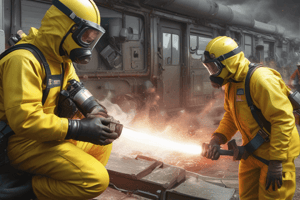Podcast
Questions and Answers
What is the primary reason for placing apparatus upwind and uphill of an incident?
What is the primary reason for placing apparatus upwind and uphill of an incident?
- To reduce the spread of hazardous materials
- To protect from hazardous liquids and vapors (correct)
- To improve communication with the incident commander
- To ensure visibility for incoming traffic
What is the recommended positioning technique for the apparatus relative to traffic?
What is the recommended positioning technique for the apparatus relative to traffic?
- Avoid using the apparatus as a shield against traffic
- Position it as close to the incident scene as possible
- Place it parallel to the road for easier access
- Use the apparatus as a barrier to shield the scene from traffic (correct)
Why should warning lights be left operating during an incident?
Why should warning lights be left operating during an incident?
- To deter pedestrians from entering the area
- To signal other emergency services for assistance
- To ensure the area is visible to oncoming traffic (correct)
- To draw attention away from the incident scene
What precaution should be taken regarding the use of flares at an incident?
What precaution should be taken regarding the use of flares at an incident?
What is the suggested angle at which to position the apparatus for effective hose deployment?
What is the suggested angle at which to position the apparatus for effective hose deployment?
Flashcards are hidden until you start studying
Study Notes
Apparatus Placement Guidelines
- Position apparatus upwind and uphill from the incident to minimize exposure to hazardous liquids and vapors.
- Reduces smoke infiltration into the work area, enhancing safety for responders.
- Utilize the apparatus as a barrier against oncoming traffic, providing protection for the incident scene.
- Keep warning lights activated to improve visibility and awareness on the scene.
- Employ traffic cones to direct and manage incoming traffic when necessary.
- Exercise caution with flares, assessing the risk of igniting flammable liquids and vapors present at the scene.
- Angle the apparatus to facilitate the easy removal of hoses from preconnected cross-lay compartments, enhancing operational efficiency.
Studying That Suits You
Use AI to generate personalized quizzes and flashcards to suit your learning preferences.




